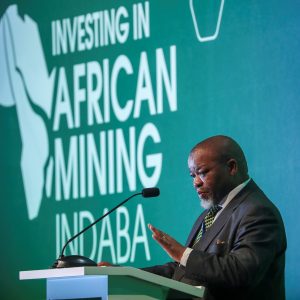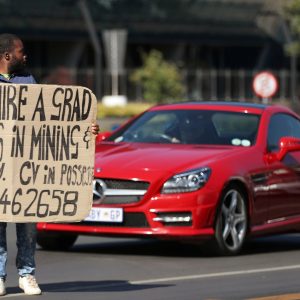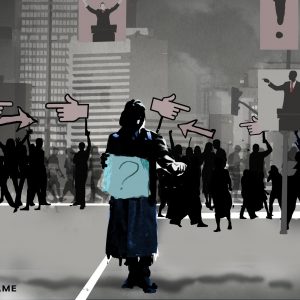Budget reallocation puts the lie to ANC’s pro-poor claims
The government’s recent budget cuts have shown that it prioritises the punted nuclear build over connecting thousands of residents in impoverished communities to the electricity grid.
Author:
21 September 2020

Budget changes announced in June have resulted in billions of rands being stripped from the pro-poor national electrification programme while the money for nuclear power remains untouched. These revised allocations plainly demonstrate the government’s priorities, revealing how nuclear power is being favoured at the cost of one the government’s few successful anti-poverty strategies. The cuts have been met with widespread condemnation.
Austrian sociologist Rudolf Goldscheid observed that the way in which money is allocated in a government’s budget “is the skeleton of the state stripped of all misleading ideologies”. It is useful to keep this telling insight at the back of our minds when we consider the revised budget allocations made for the Department of Mineral Resources and Energy during the recent supplementary budget.
The supplementary budget, passed by Minister of Finance Tito Mbweni on 24 June, was necessary because funds needed to be found to pay for the interventions required to address Covid-19. Known as “top-slicing” in budgetary terms, this process involves reducing budget allocations in existing budget commitments and reallocating them for a different purpose.
Related article:
In total, the National Treasury determined to reallocate a total of R130 billion from existing budgets. Of this amount, R54.4 billion comes from national departmental allocations, R13.8 billion from conditional grants to provinces and R12.6 billion from conditional grants to local governments. (These grants are ring-fenced for specific purposes.) The remaining amount comes from reductions in equitable share allocations to provinces.
To protect ongoing and essential service delivery, departments were instructed to cut the budgets of “projects where implementation dates could be moved out to the next financial year, or projects and spending activities that are not critical to the core service delivery requirements of the department”.
Crippling a successful programme
The Department of Mineral Resources and Energy was originally allocated R9.34 billion for 2020-2021, but this was cut by R1.57 billion (16.8%) to R7.77 billion. The vast majority of this cut, some R1.5 billion or 96%, came from a massively reduced budget for the Integrated National Electrification Programme (INEP), which has had its budget cut by no less than 31% overall.
This programme is aimed at ensuring that all who live in South African have domestic access to electricity and is viewed as a priority, which has been reflected in its success since 1994. The pressing issue of energy poverty aside, the government has increased domestic access to electricity from about 35% then to around 80% today. It has repeatedly argued that it views the programme as an essential means by which to advance socio-economic development, create jobs and alleviate poverty.
Related article:
Last year, 243 000 additional homes were connected to the national grid while a further 13 000 received non-grid electrification. It is no wonder then that the National Development Plan for 2030 describes the INEP as “the most successful achievement in the energy sector over the past 15 years”. Part of the success of the programme comes from its ability to spend the funds allocated to it, as it has a good track record of not having to return unspent funds to the treasury – a problem that continues to plague other infrastructural development programmes.
The department admitted in July that “the reduction will delay the implementation of planned bulk infrastructure projects, which are critical for laying the foundation for household connections”. In addition, it stated that 43 000 fewer homes would be connected to electricity in 2020 than would have been the case with its original budget allocation. This, it observed, would have “a significant negative impact on the Eastern Cape, Limpopo and KwaZulu-Natal as these provinces have the largest electricity backlogs”.
Cuts slammed
Parliament’s portfolio committee on minerals and energy was unanimous in condemning the budget cuts to the INEP. It suggested that the department make the necessary savings elsewhere, and recommended that Minister of Mineral Resources and Energy Gwede Mantashe approach Mboweni before the budget is reconsidered in the medium-term budget statement in October to demand more funds for the programme.
Criticism also came from civil society groups. In a submission on the supplementary budget, the Organisation Undoing Tax Abuse stated: “It is difficult to understand how the reduction in spending on electrification and energy efficiency fall within the criteria of treasury’s instruction to cut ‘spending activities that are not critical to the core service delivery requirements of the department’.”
Related article:
The government’s constitutionally mandated advisory body, the Financial and Fiscal Commission, also lamented the cuts, questioning why they had been made to a “performing grant”. The commission cautioned that the cuts would lead to “uncertainties” in the future of the programme. These uncertainties were confirmed by the department’s chief financial officer, Yvonne Chetty, who told the portfolio committee that the cuts “would be felt for many years”. She added that the department had received no assurance from the treasury that the budget for the programme would return to its previous levels.
Reminding ourselves of Goldshield’s observation, we need to look at which programmes in the department were not cut in the supplementary budget to reveal where the government’s priorities actually lie.
Superficial adjustment for nuclear energy
One major programme that received only a miniscule cut was nuclear energy. Originally allocated R1.1 billion, the budget was reduced by just R10 million. Crucially, this cut should be seen in the context of significant budget increases being allocated to nuclear energy in South Africa over the medium term. These allocations are clearly in line with the government’s intention to procure 2 500MW of nuclear energy from 2030 as confirmed in the 2019 Integrated Resource Plan, which stated that South Africa needed to “commence preparations for a nuclear build programme”.
In the 2017-2018 financial year, nuclear energy received an allocation of R793 million. This increased by nearly 10% in nominal terms in 2018-2019 to R870 million. In 2019/2020, the allocation for nuclear energy increased again, this time by over 17% to R1.04 billion. And in the current year, as we have seen, the unchanged allocation is R1.1 billion. These increases should be contrasted with single-digit increases for other programmes in the department. What it all means is that over the past four years, the budget for nuclear energy has increased by about 20% in real terms, taking inflation into account.
Related article:
This reveals that the government has been directing more taxpayer money into nuclear energy at the expense of other programmes in the department, specifically, or in the government more generally. Should we be surprised, therefore, that the supplementary budget prioritised nuclear energy over the INEP? Interestingly, it is not the first time in recent years that this has happened. In 2018-2019, the department transferred R55 million of the programme’s approved budget to nuclear energy to avoid overspending “funding for services associated with the new nuclear build programme”.
The entity that will be providing the majority of these “services” will be the South African Nuclear Energy Corporation (Necsa), where the vast majority of the budget set aside for nuclear power ends up. For example, Necsa will receive the bulk of the R1.1 billion allocated to nuclear power in 2020 – a total of R940 million.
Necsa is a state-owned enterprise (SOE) tasked with promoting nuclear energy and radiation sciences in South Africa. Like many other SOEs, Necsa has been in a state of complete chaos for a number of years. It’s been making significant financial losses running into hundreds of millions of rands since 2014, and expects to lose at least R61 million in the current financial year.
A record of governance failures
These losses should be set against the complete collapse of financial controls in Necsa dating from 2015, which has seen it receive audit disclaimers from the Auditor-General of South Africa for the past two financial years. An audit disclaimer is issued when financial records are so poor that an opinion cannot be formed on the accuracy of the financial records of the institution being audited.
In 2018, the auditor general recorded irregular expenditure of R30 million at Necsa and drew attention to the flouting of procurement regulations and the wholesale breakdown of expenditure, asset and revenue management. It reported that “leadership did not adequately exercise oversight responsibility regarding financial and performance reporting and compliance as well as related internal controls”. The following year the auditor general recorded R51 million of irregular expenditure, among other things, noting that once again senior managers “did not exercise adequate oversight responsibility regarding compliance with laws and regulations”.
Related article:
Among many other destabilising issues, the period since 2015 has seen the firing or resignation of numerous Necsa board members and chairpersons, accusations of illegal financial transfers within Necsa’s group companies, suspected ministerial interference, allegations of nepotism, and protracted litigation between board members and the government. It is against this shambolic background that Mantashe finally admitted in October 2019 that governance at Necsa “had collapsed”. It is also against this hair-raising background that Necsa is receiving significantly increased budget allocations over coming years, all in the apparent interest of pursuing new nuclear power in South Africa.
In June, the department issued a “request for information” from nuclear vendors – a call to vendors to show what they can do and how much they will charge for it. This request clearly indicates that the new nuclear build is being pursued with vigour. If it does indeed go ahead, we can only speculate on which other budgets providing infrastructure or services to poor and marginalised people in South Africa will be cut to further the government’s incomprehensible nuclear plans.
As international experience as well as the domestic examples of megaprojects like Medupi and Kusile power stations demonstrate, any nuclear build is likely to end up being grossly over budget and seriously delayed. There is one thing, however, we can say with certainty about a new nuclear build: it will provide plentiful opportunities, like Medupi and Kusile, for the elite to further enrich themselves through suspect tenders and dodgy contracts. Here we see, in all its startling clarity, the budget “stripped of all misleading ideologies”.





